Louisiana, a haven for bird lovers, is home to 23 sparrows found in Louisiana, each with unique characteristics and songs. Feel more familiar when you see this type of sparrow.
List of 22 Sparrows information with Photo
1. American Tree Sparrow (Spizelloides arborea):
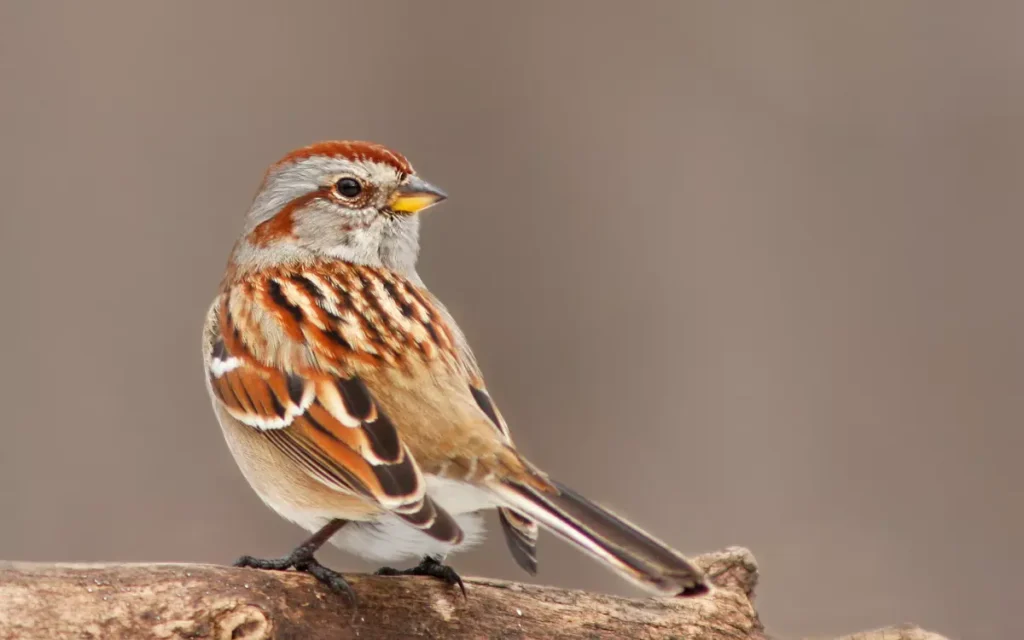
The American Tree Sparrow is a small, charming bird easily recognized by its rusty cap and black eye spot. These sparrows are winter visitors in many parts of the U.S., including Louisiana, and migrate north to Canada for breeding.
They mainly eat seeds and insects, which they forage on the ground. Their nests are built on the ground in open tundra, using grasses and lined with fine materials. Typically, a female American Tree Sparrow will lay 4 to 6 eggs per year, once during the breeding season.
- Length: 5.5 in (14 cm)
- Weight: 0.5-1.0 oz (13-28 g)
- Wingspan: around 9.4 in (24 cm)
2.Chipping Sparrow (Spizella passerina):
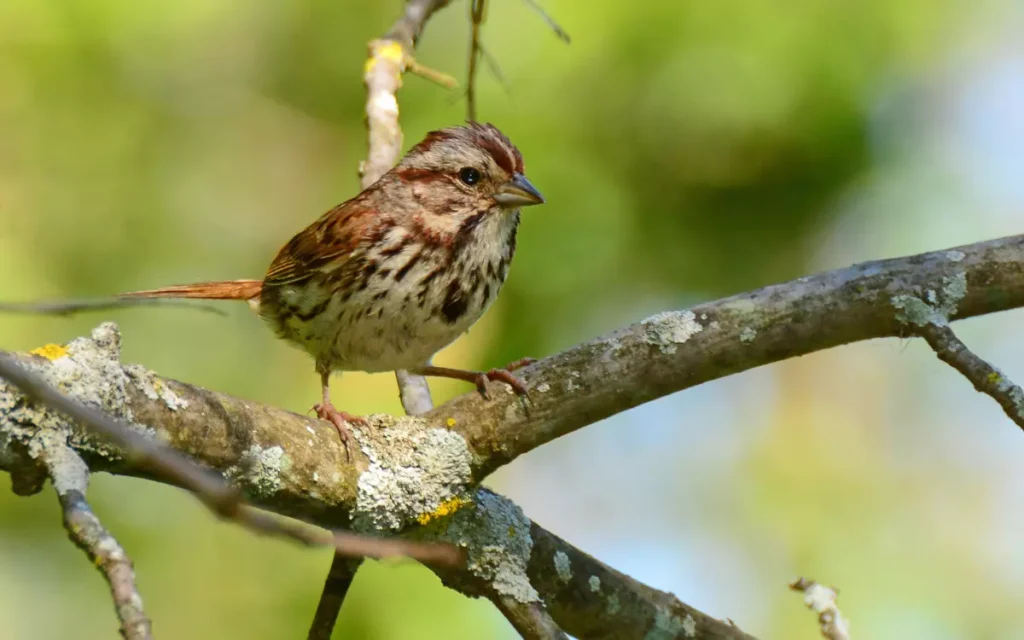
The Chipping Sparrow is a small, slender bird known for its rusty red cap and black eye line. These sparrows are common across North America and can be seen in various habitats, including gardens and parks.
They primarily eat seeds, but during the breeding season, they also catch insects. Chipping Sparrows build their nests low in bushes or trees, weaving them out of grass and lining them with hair. Each year, they typically lay 3 to 4 eggs, and they may have more than one brood.
- Length: 4.7-5.9 in (12-15 cm)
- Weight: 0.4-0.6 oz (11-16 g)
- Wingspan: around 8.3 in (21 cm)
3.Clay-colored Sparrow (Spizella pallida):
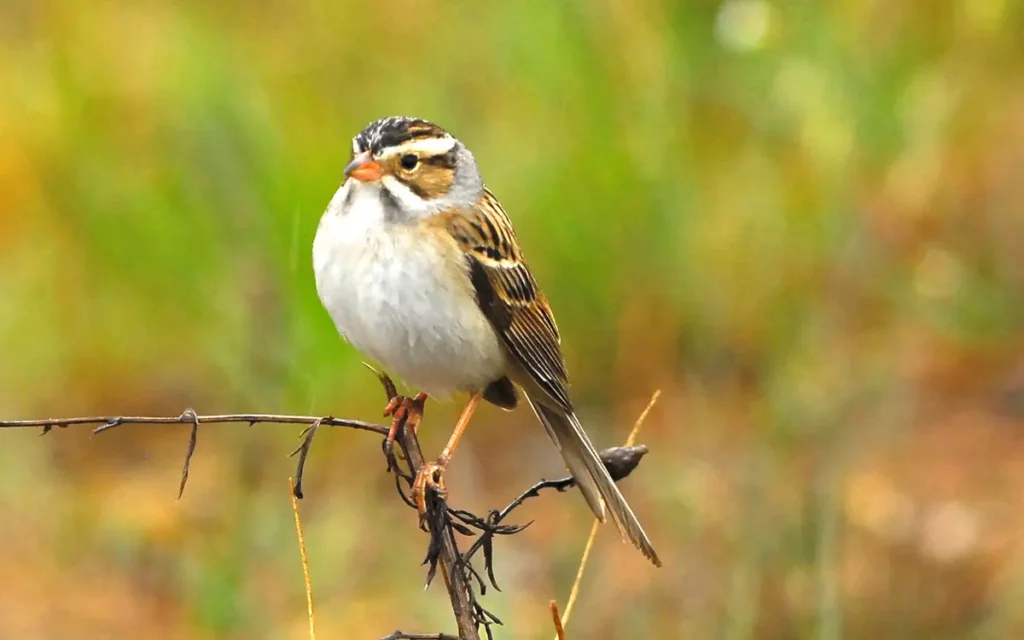
The Clay-colored Sparrow is a small bird notable for its pale, gray-brown body and distinctive black and white face markings. This sparrow is a summer visitor in the northern U.S. and Canada, spending winters in Mexico.
It feeds primarily on seeds and adds insects to its diet during the breeding season. Clay-colored Sparrows build their nests low in shrubs or on the ground, using grass and sometimes incorporating animal hair. Each breeding season, they typically lay 3 to 5 eggs.
- Length: 4.7-5.9 in (12-15 cm)
- Weight: 0.4-0.6 oz (12-17 g)
- Wingspan: 7.1-7.9 in (18-20 cm)
4. House Sparrow (Passer domesticus):

The House Sparrow is easily recognized by its chunky body, gray head, and black bib. These birds are not native to North America but are now found almost everywhere, living near humans in urban and rural areas. They eat a wide variety of seeds and scraps, often visiting bird feeders.
House Sparrows build messy nests of grass and debris in shelters like building eaves or tree holes. They are prolific breeders, typically laying 3 to 7 eggs multiple times per year.
- Length: 5.9-6.7 in (15-17 cm)
- Weight: 0.9-1.1 oz (27-30 g)
- Wingspan: 7.5-9.8 in (19-25 cm)
5.Field Sparrow (Spizella pusilla):
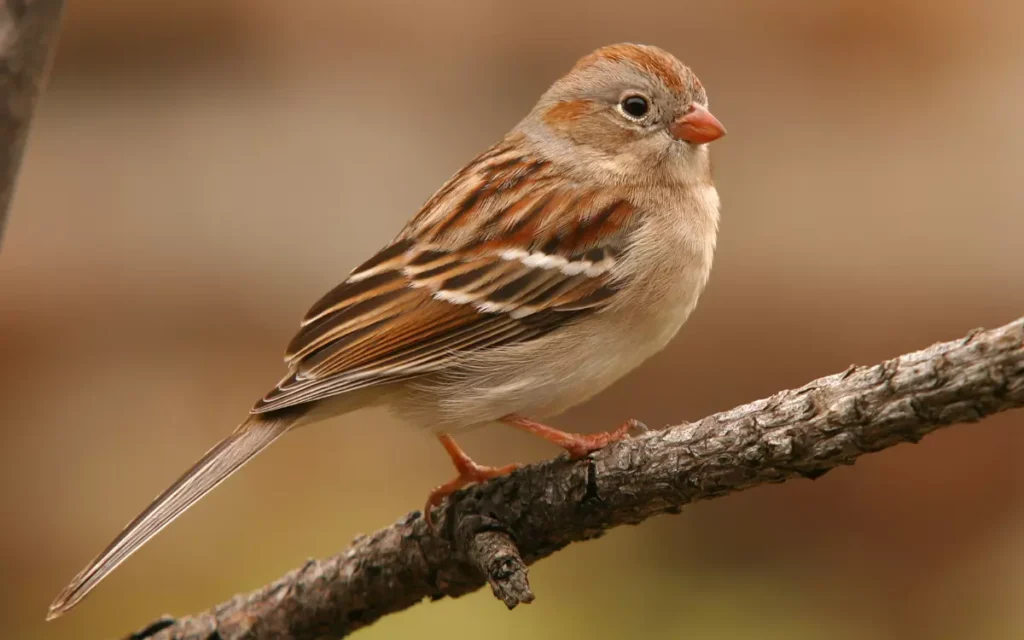
The Field Sparrow is a small bird, recognized by its soft reddish-brown cap and clear, white eye-ring. It is commonly found in open woodlands and grassy fields across North America. These sparrows primarily eat seeds, but they will also eat insects during the breeding season.
Field Sparrows build their nests close to the ground in bushes or clumps of grass, using grasses and hair for construction. Each year, they typically lay 3 to 5 eggs and can have multiple broods, especially in warmer climates.
- Length: 5.9-6.7 in (15-17 cm)
- Weight: 0.9-1.1 oz (27-30 g)
- Wingspan: 7.5-9.8 in (19-25 cm)
6. Brewer’s Sparrow (Spizella breweri):

The Brewer’s Sparrow is a small, unassuming bird with a plain gray-brown body and thin, pointed bill. This sparrow is primarily found in the sagebrush habitats of the western United States during the breeding season and migrates to the southwestern U.S. and Mexico for the winter.
It mainly eats seeds and insects. Brewer’s Sparrows build their nests on the ground or in low shrubs, camouflaging them with surrounding vegetation. Typically, they lay 3 to 4 eggs per breeding season and can have up to two broods per year.
- Length: 5.1-5.9 in (13-15 cm)
- Weight: 0.4-0.5 oz (11-14 g)
- Wingspan: 7.1-7.9 in (18-20 cm)
7. Black-throated Sparrow (Amphispiza bilineata):

The Black-throated Sparrow is easily recognized by its striking black throat and face contrasted with a white belly and gray back. This bird is primarily found in the deserts of the southwestern U.S., living year-round in some areas and migrating slightly for the winter. Its diet consists mainly of seeds and insects, especially during the breeding season.
Black-throated Sparrows build their nests close to the ground in shrubs, using grasses and plant fibers. They typically lay 2 to 4 eggs per breeding season, often having two broods if conditions are favorable.
- Length: 4.7–5.5 in (12–14 cm)
- Weight: 0.4–0.5 oz (11–14 g)
- Wingspan: around 7.7 inches (20 cm)
8. Lark Sparrow (Chondestes grammacus):
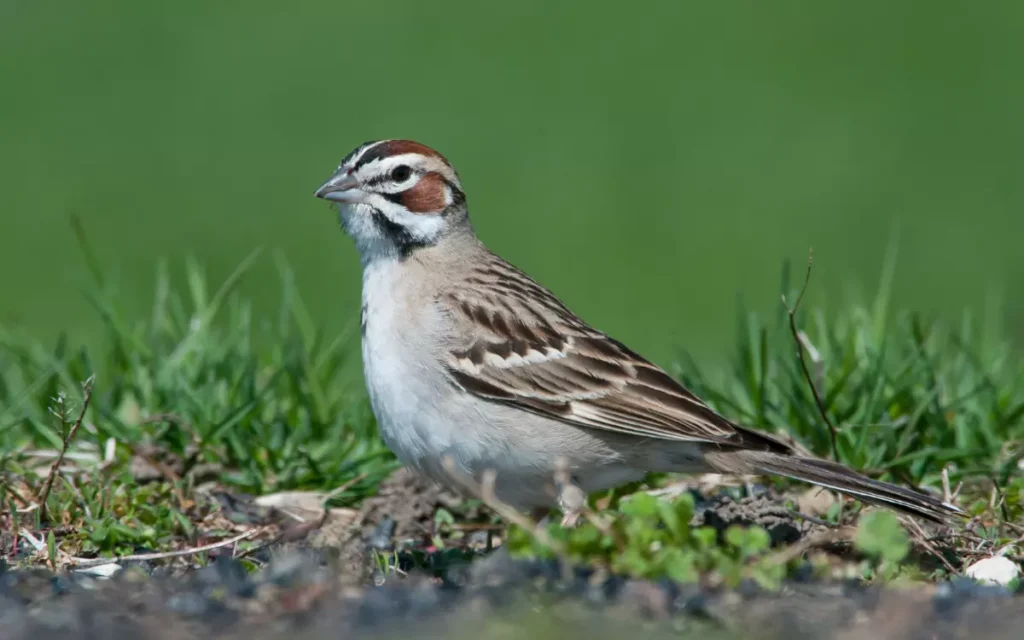
The Lark Sparrow is distinct with its bold facial pattern, featuring a white stripe above the eye and a dark cheek patch. These sparrows are seasonal migrants, breeding across the central and western U.S. and wintering in the southwestern U.S. and Mexico. They primarily feed on seeds and insects, with a diet that shifts seasonally.
Lark Sparrows build their nests on the ground or low in bushes, using grasses and fine materials. They typically lay 3 to 5 eggs per breeding season, sometimes having more than one brood depending on environmental conditions.
- Length: 5.9-6.7 in (15-17 cm)
- Weight: 0.8-1.2 oz (24-33 g)
- Wingspan: around 11.0 in (28 cm)
9.Fox Sparrow (Passerella iliaca):
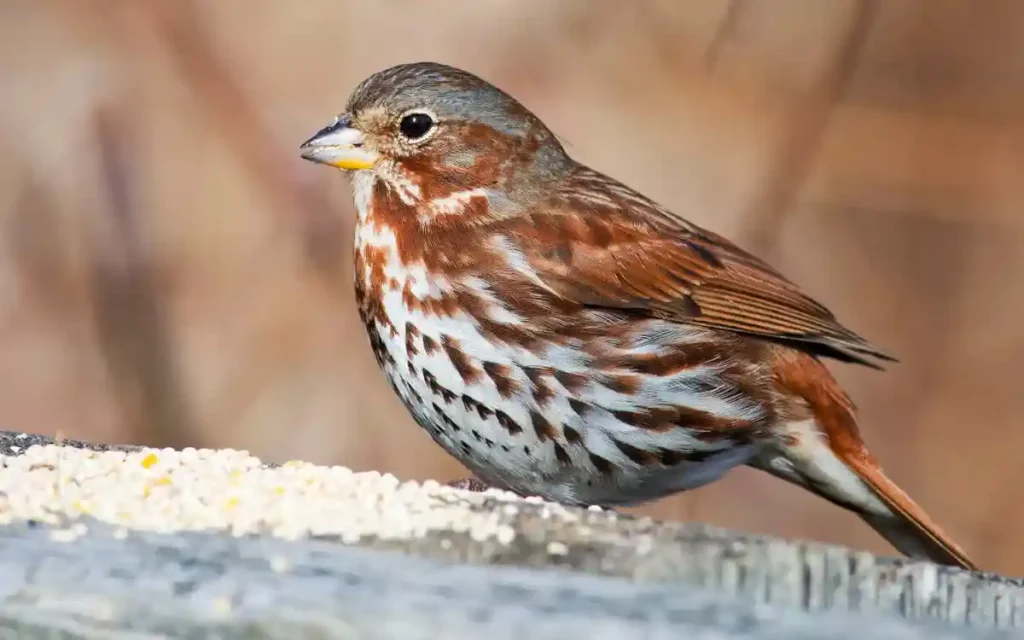
The Fox Sparrow is noticeable for its large size and rich, reddish-brown coloring. These sparrows are seasonal migrants, appearing in different parts of the U.S. depending on the season. They favor thick brushy areas where they primarily feed on seeds and insects, scratching at the ground with a double-footed kicking motion.
Fox Sparrows build their nests on the ground or in low bushes, making them out of twigs and leaves, lined with finer grasses. They typically lay 3 to 5 eggs per breeding season, often producing only one brood each year.
- Length: 5.9-7.5 in (15-19 cm)
- Weight: 0.9-1.6 oz (26-44 g)
- Wingspan: 10.5-11.4 in (26.7-29 cm)
Read also: 14 Ducks found in Louisiana with IDs and photos
10.Song Sparrow (Melospiza melodia):
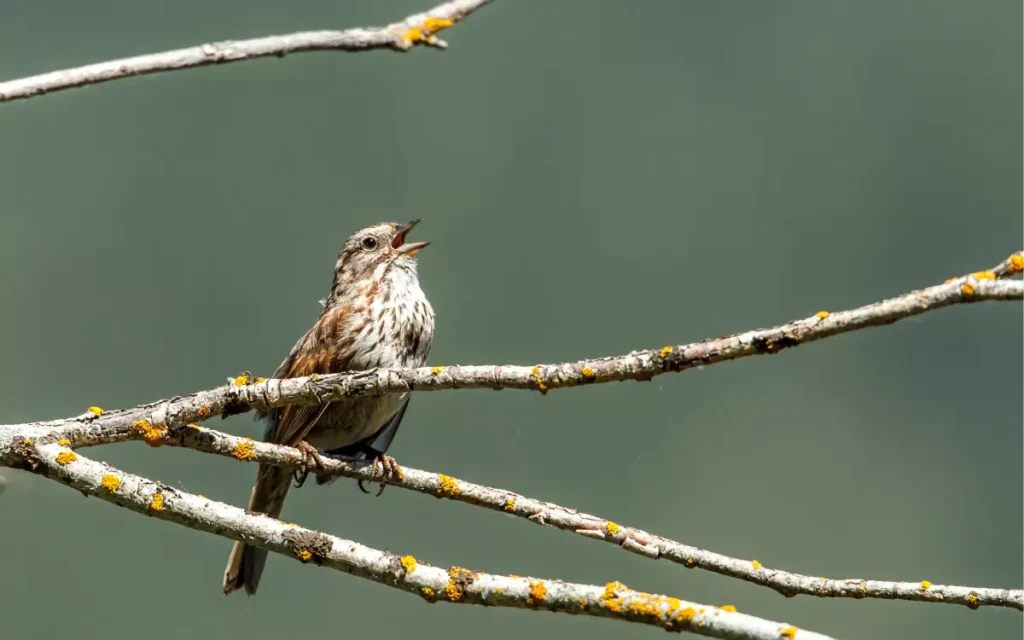
The Song Sparrow is known for its streaky brown plumage and a distinctive, dark spot on its chest. It is a common resident across most of North America, adapting well to varied habitats from wetlands to gardens. These sparrows mainly eat insects and seeds, foraging on the ground or in low vegetation.
Song Sparrows are prolific builders, constructing their nests either on the ground or in shrubs, made of grass and lined with soft materials. They typically lay 3 to 5 eggs per nesting session and can have multiple broods throughout the breeding season.
- Length: 5.5-7 in (14-18 cm)
- Weight: 0.42-1.87 oz (11.9-53 g)
- Wingspan: 7.1-10.0 in (18-25.4 cm)
11. Lincoln’s Sparrow (Melospiza lincolnii):
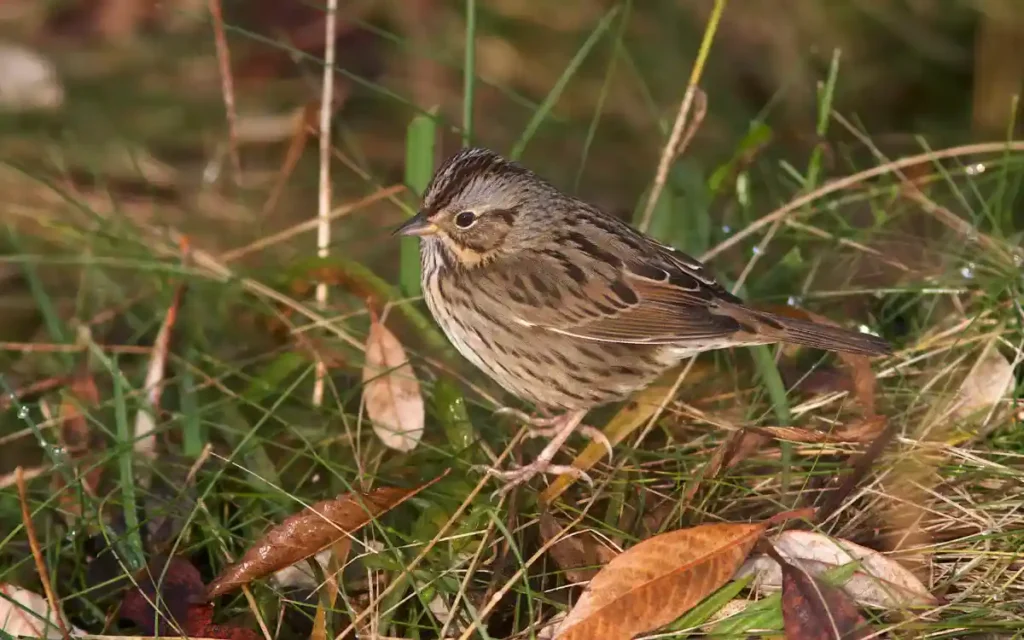
The Lincoln’s Sparrow is a subtle beauty, known for its buff-colored breast finely streaked with black and a grayish face with a fine, black eye line. These birds are migratory, spending summers in Canada and the northern U.S. for breeding and winters in the southern U.S. and Mexico. They primarily feed on seeds and insects, foraging in dense underbrush.
Lincoln’s Sparrows construct their nests on or near the ground in hidden locations, using grasses and moss, and lining them with fine materials. They typically lay 3 to 5 eggs per breeding season, usually producing just one brood each year.
- Length: 5.1-5.9 in (13–15 cm)
- Weight: 0.6-0.7 oz (17-19 g)
- Wingspan: 7.5-8.7 in (19–22 cm)
12. Swamp Sparrow (Melospiza georgiana):
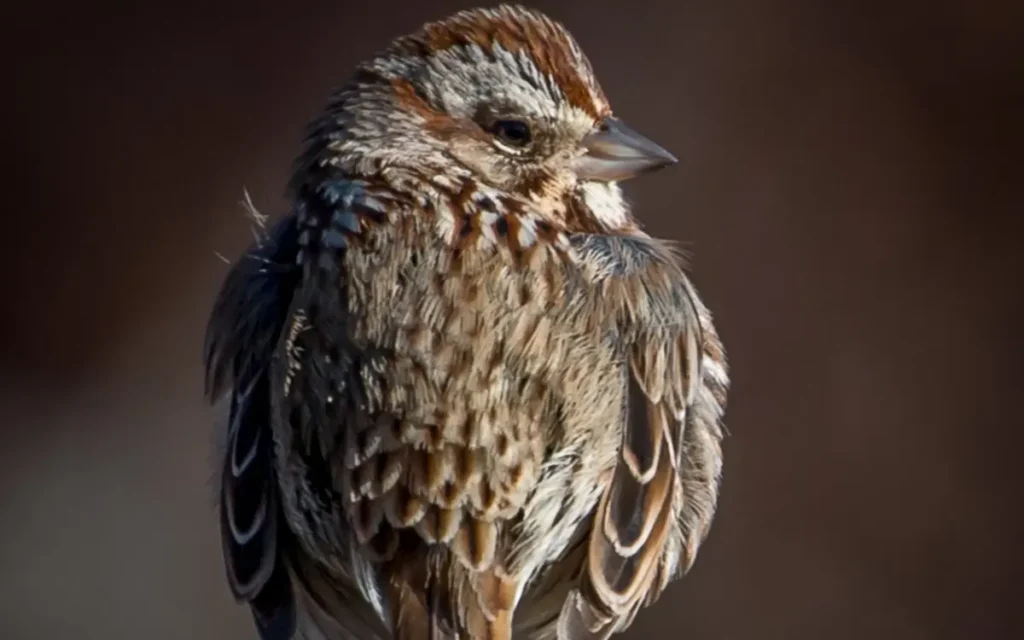
The Swamp Sparrow stands out with its rusty cap and gray face, making it a striking sight in wetlands. This bird is a year-round resident in parts of its range but migrates to the southern U.S. during winter. It thrives in marshy areas, feeding primarily on insects and seeds.
Swamp Sparrows build their nests close to the ground, often in dense marsh vegetation, making them hard to spot. They construct their homes from grasses and sedges, lined with finer materials. Typically, a Swamp Sparrow lays 3 to 5 eggs per nesting attempt and may have multiple broods in a season.
- Length: 4.7-5.9 in (12-15 cm)
- Weight: 0.5-0.8 oz (15-23 g)
- Wingspan: 7.1-7.5 in (18-19 cm)
13.White-throated Sparrow (Zonotrichia albicollis):
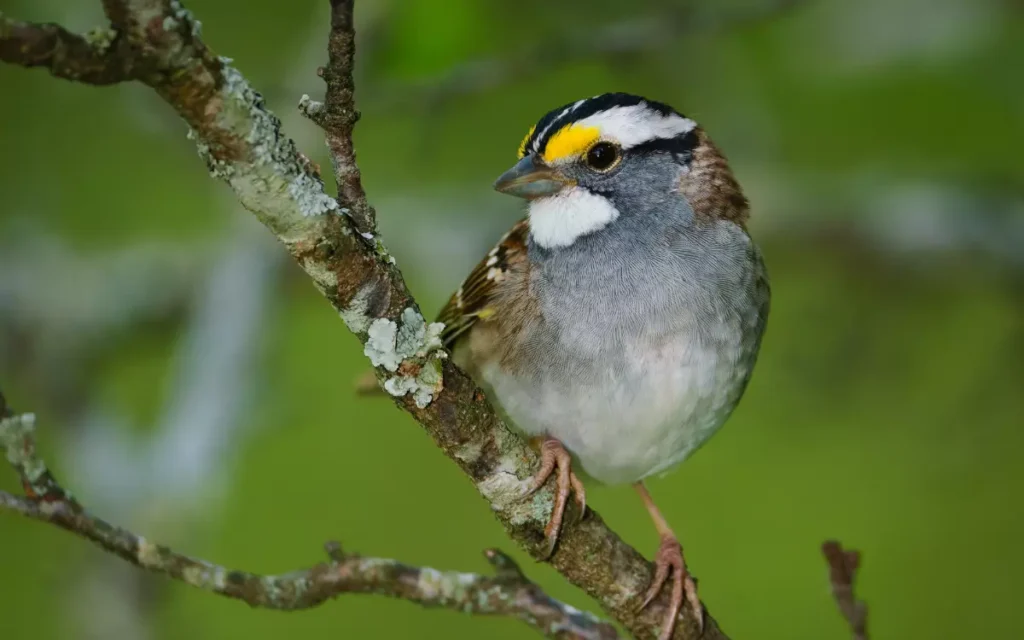
The White-throated Sparrow is recognized by its striking white throat and the black and white stripes on its head. These birds are migratory, wintering in the southern U.S. and spending the breeding season in Canada and the northern U.S. They mainly eat seeds and insects, and during the winter, they often visit bird feeders.
White-throated Sparrows build their nests on the ground or in low bushes, using grass, leaves, and twigs, lined with softer materials like hair. They typically lay 3 to 5 eggs per breeding season, usually having one brood each year.
- Length: 5.9 – 7.5 in (15 – 19 cm)
- Weight: 0.78 -1.13 oz (22 – 32 g)
- Wingspan: around 9.1 in (23 cm)
14. Harris’s Sparrow (Zonotrichia querula):
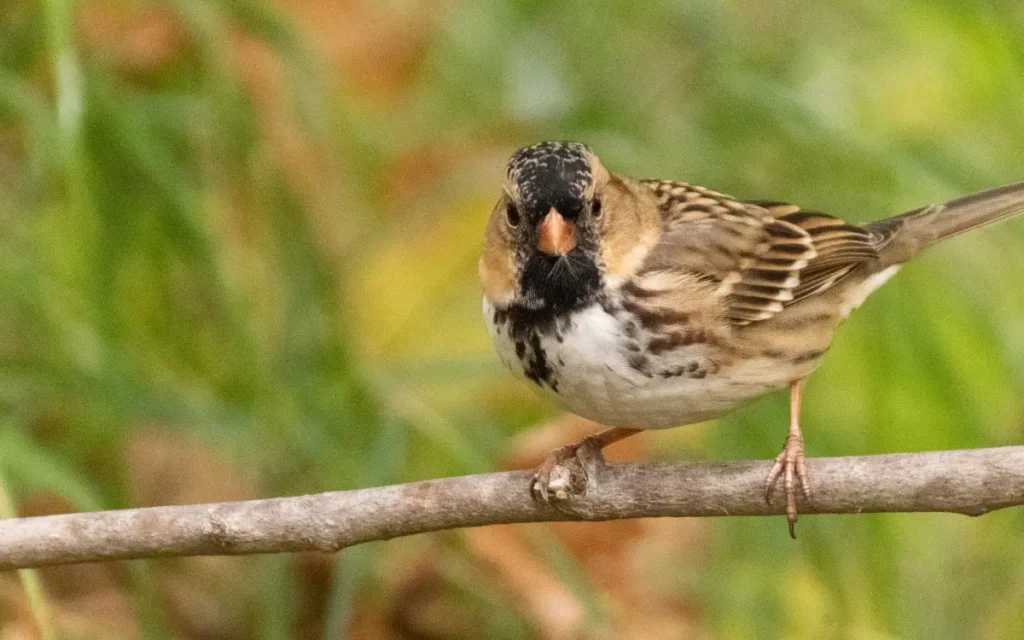
The Harris’s Sparrow is notable for its black bib and forehead, contrasting with its gray body and brown wings. It is North America’s largest sparrow and is migratory, wintering in the central U.S. and breeding in northern Canada. This sparrow primarily feeds on seeds and insects.
Harris’s Sparrows build their nests on the ground in the tundra, hidden among low shrubs or grasses. They construct them from twigs and grasses, lined with softer materials. Each breeding season, they typically lay 3 to 5 eggs, generally producing only one brood per year.
- Length: 6.7-7.9 in (17-20 cm)
- Weight: 0.92-1.73 oz (26-49 g)
- Wingspan: around11 in (27.9 cm)
15. White-crowned Sparrow (Zonotrichia leucophrys):

The White-crowned Sparrow stands out with its bold black and white stripes on its head. This sparrow is migratory, spending winters in much of the U.S. and breeding in northern Canada and Alaska. It eats a mix of seeds and insects, adapting its diet to the available resources.
White-crowned Sparrows build their nests on the ground or in low vegetation, using twigs, grasses, and leaves, lined with finer materials like hair. Typically, they lay 3 to 5 eggs per breeding season, often producing more than one brood depending on the climate and region.
- Length: 5.9-6.3 in (15-16 cm)
- Weight: 0.9-1.0 oz (25-28 g)
- Wingspan: 8.3-9.4 in (21-24 cm).
16.Savannah Sparrow (Passerculus sandwichensis):

The Savannah Sparrow is easily identified by its streaky brown back and yellowish flecks above its eyes. This sparrow is widely distributed across North America, adjusting to various habitats but favoring open fields and marshes. It mainly consumes seeds and insects, with a diet that varies seasonally.
Savannah Sparrows build their nests on the ground, cleverly hidden among grass or low vegetation. They construct them from grass and line them with finer materials for insulation. Typically, they lay 3 to 5 eggs per breeding season and can have multiple broods, especially in warmer climates.
- Length: 4.3-5.9 in (11-15 cm)
- Weight: 0.5-1.0 oz (15-28 g)
- Wingspan: 7.9-8.7 in (20-22 cm)
17. Grasshopper Sparrow (Ammodramus savannarum):
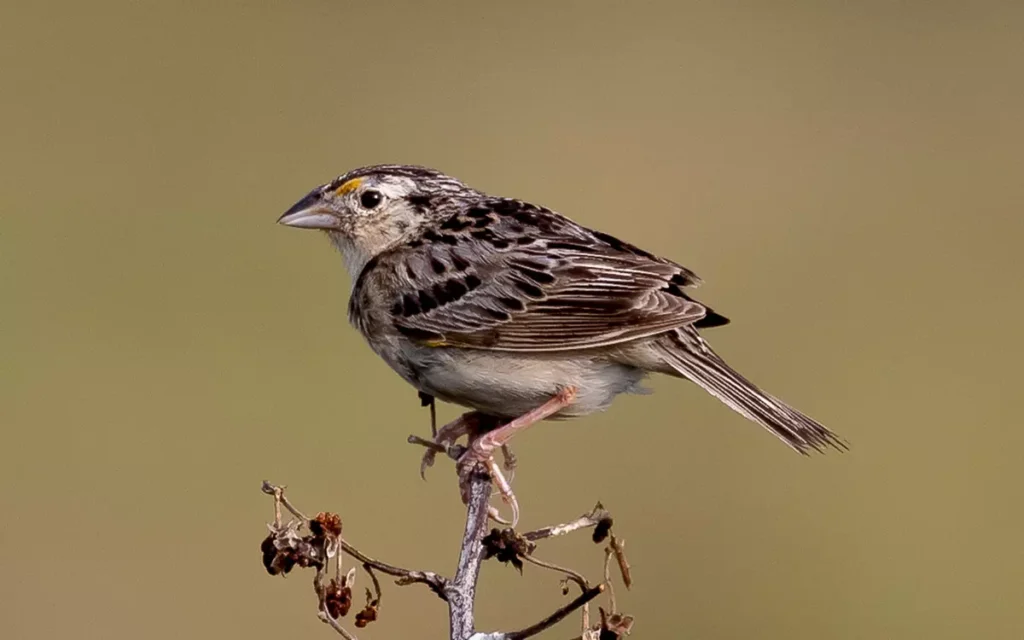
The Grasshopper Sparrow is distinguished by its flat head and buff-colored breast with few streaks. These sparrows are resident to migratory, depending on their location within North America. They prefer open grasslands where they are well camouflaged.
Their diet mainly consists of seeds and insects, particularly grasshoppers, which gives them their name. Grasshopper Sparrows build their nests on the ground, hidden under clumps of grass to protect from predators. They typically lay 3 to 5 eggs per breeding season and are known to have one or two broods annually.
- Length: 4.3-4.5 in (10.8-11.5 cm)
- Weight: 0.5-0.7 oz (14-20 g)
- Wingspan: around 7.9 in (20 cm).
18. Henslow’s Sparrow (Ammodramus henslowii):
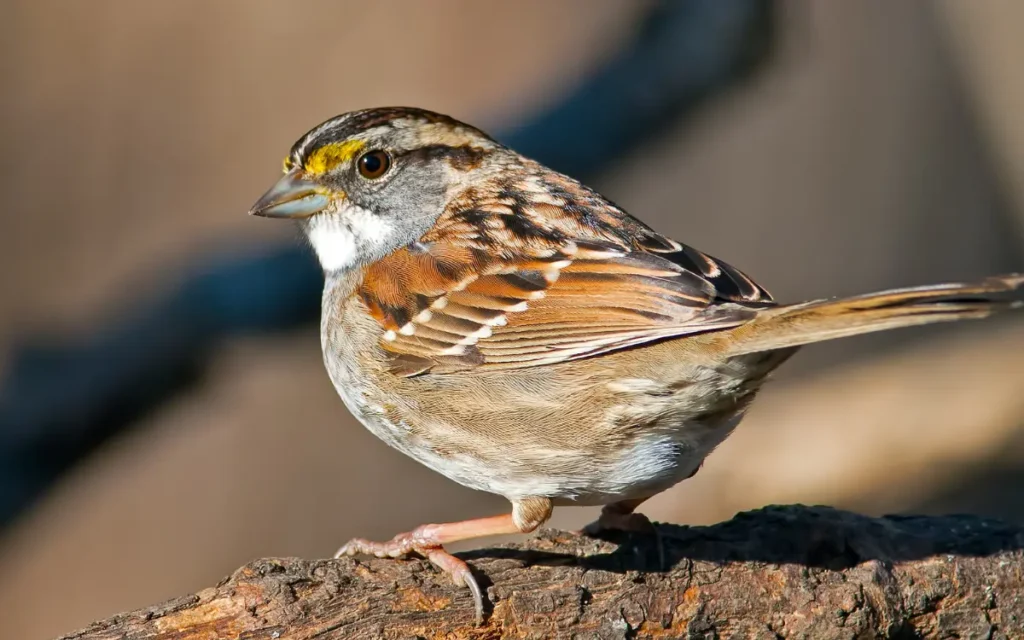
The Henslow’s Sparrow is recognized by its olive-green face and rusty crown, making it a well-camouflaged bird in its natural habitat. This sparrow is highly secretive and tends to inhabit tall grass prairies and meadows. They are mainly found in the eastern and central United States, often in declining numbers due to habitat loss.
Their diet consists largely of insects and seeds. Henslow’s Sparrows build their nests on the ground, hidden among thick grass. They typically lay 3 to 5 eggs per season and generally have just one brood per year, although the specifics can vary with regional conditions.
- Length: 4.3-5.1 in (11-13 cm)
- Weight: 0.4-0.5 oz (11-15 g)
- Wingspan: 6.3-7.9 in (16-20 cm)
19. Le Conte’s Sparrow (Ammodramus leconteii):
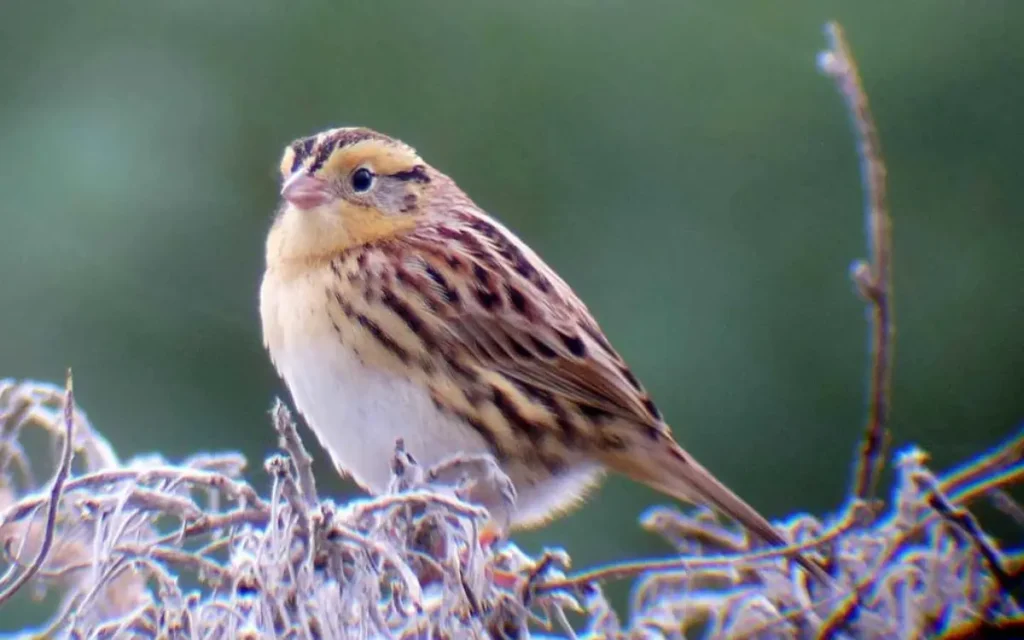
The Le Conte’s Sparrow is noted for its orange-brown face and fine, gray streaks on the nape, blending well with its marshy habitats. This sparrow is somewhat elusive and migratory, typically found in tall grass prairies and wet meadows. They winter in the southern United States and migrate to central Canada for breeding.
Le Conte’s Sparrows mainly consume insects and seeds, utilizing the dense vegetation for food and cover. They construct their nests directly on the ground, hidden under grass or shrubs. Typically, they lay 3 to 5 eggs per breeding season and usually have one brood each year.
- Length: 4.3-5.1 in (11-13 cm)
- Weight: 0.35-0.53 oz (10-15 g)
- Wingspan: around 7.1 in (18 cm)
20. Nelson’s Sparrow (Ammodramus nelsoni):
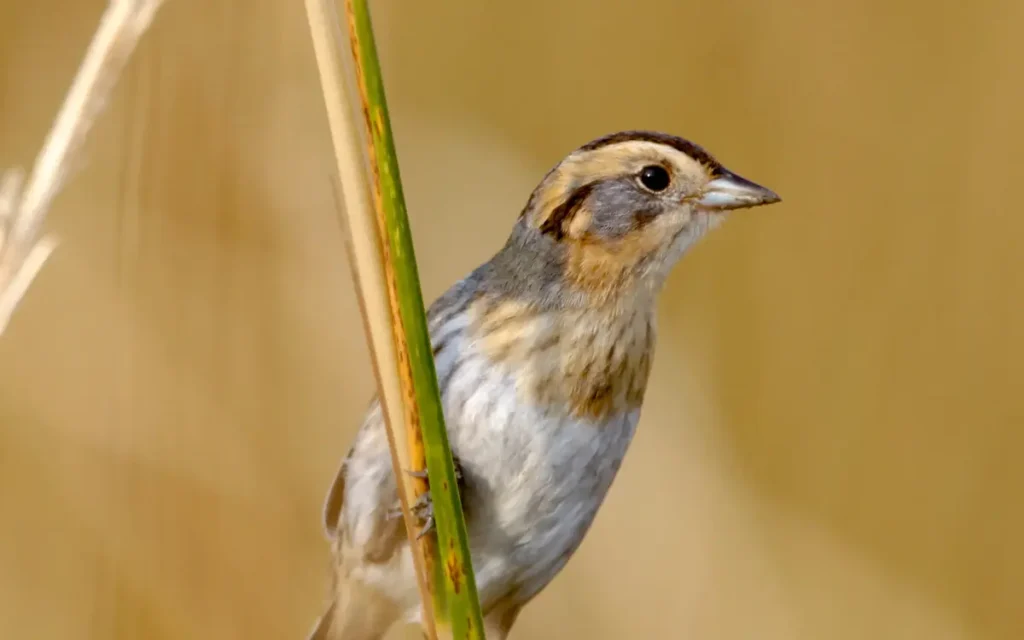
The Nelson’s Sparrow is notable for its orange face and grayish-brown body, with subtle streaks that help it blend into marsh environments. This bird is migratory, spending its summers in the northern United States and Canada, and winters along the U.S. Gulf Coast. Nelson’s Sparrows primarily feed on insects and some seeds, suited to their marshy habitats.
They build their nests above ground in dense marsh vegetation, making them difficult to spot. Typically, Nelson’s Sparrows lay 3 to 5 eggs per season, and they generally have one brood per year, focusing their reproductive efforts on their brief northern stay.
- Length: 4.7-5.5 in (12-14 cm)
- Weight: 0.35-0.53 oz (10-15 g)
- Wingspan: around 6.7 in (17 cm)
21. Seaside Sparrow (Ammospiza maritima):
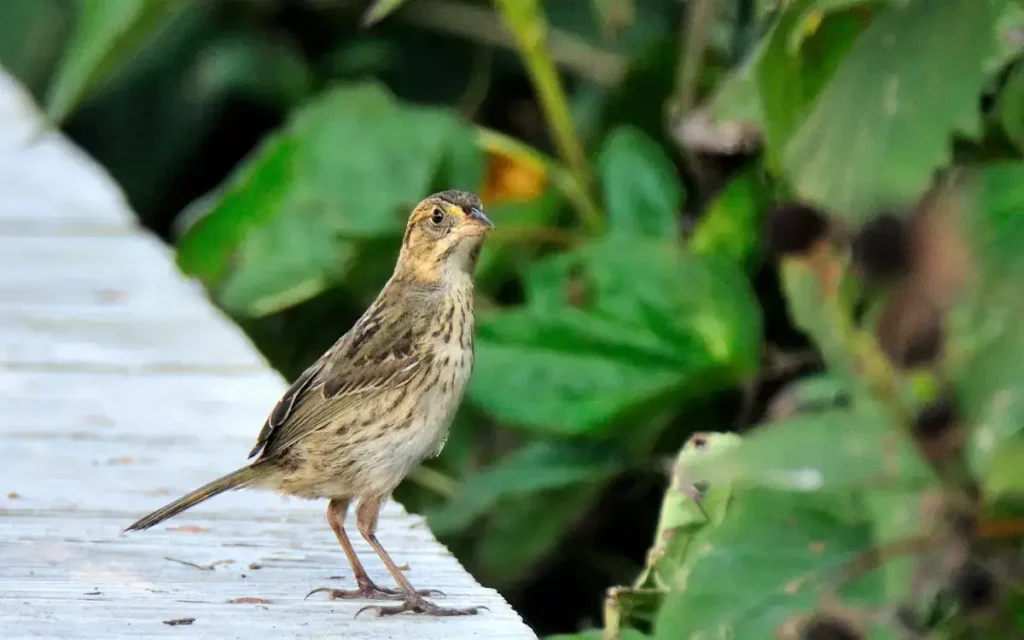
The Seaside Sparrow is distinguished by its grayish body and a yellow spot before its eye, which makes it well-suited for its coastal marsh habitat. This sparrow is non-migratory, staying within the same general area year-round along the Atlantic and Gulf Coasts of the United States.
It primarily feeds on insects, small crustaceans, and seeds, exploiting the rich resources of its marshy environment. Seaside Sparrows build their nests slightly above ground in dense marsh vegetation, which protects them from tidal fluctuations. Typically, they lay 3 to 5 eggs per season and are likely to have multiple broods throughout the breeding period.
- Length: 5.1-5.9 in (13-15 cm)
- Weight: 0.7-1.0 oz (19-29 g)
- Wingspan: 7.1-7.9 in (18-20 cm)
22. Saltmarsh Sparrow (Ammospiza caudacuta):
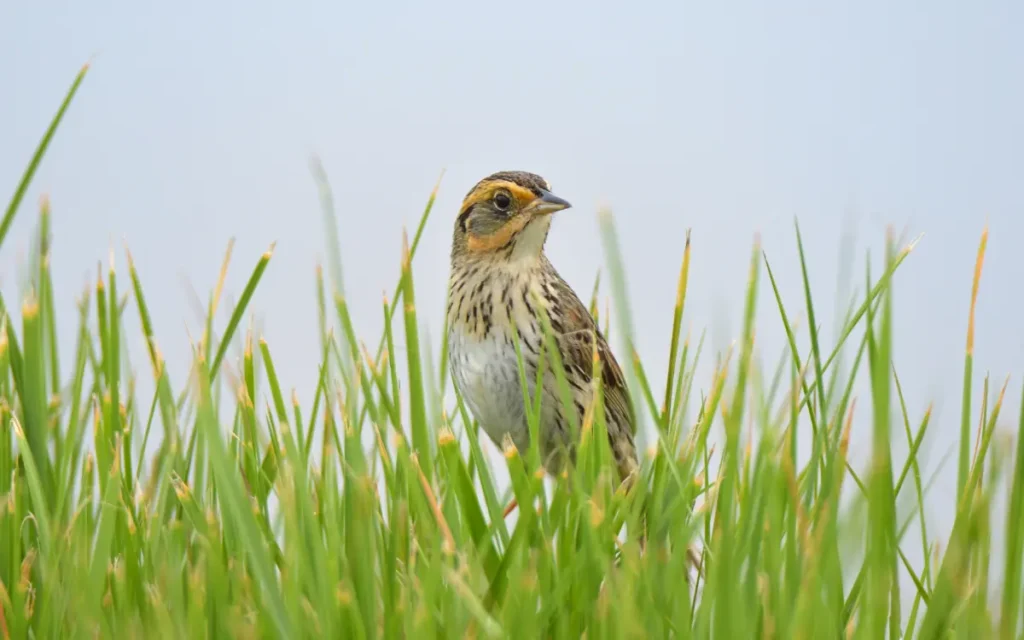
The Saltmarsh Sparrow stands out with its streaked orange-brown body and gray face, perfect for blending into its coastal marsh habitats. This sparrow is non-migratory, residing year-round along the Atlantic coast of the United States. It feeds primarily on insects and seeds, which are abundant in its salt marsh environment.
Saltmarsh Sparrows build their nests just above the high tide line in dense marsh vegetation to protect against flooding. They typically lay 3 to 4 eggs per breeding season and are known for having one to two broods per year, depending on environmental conditions.
- Length: 5-6 in (12.7-15.2 cm)
- Weight: 0.49-0.81 oz (14-23.1 g)
- Wingspan: 7.0-8.3 in (17.8-21 cm)
Conservation and Challenges for Sparrows in Louisiana:
Habitat loss and climate change threaten sparrows in Louisiana, reducing places where they can live and find food. Efforts to protect these birds include creating protected areas and restoring wetlands.
Conservationists also focus on raising awareness about the impacts of environmental changes on local wildlife. Learn more about other local birds like the Beautiful Geese and Swans found in Louisiana, which also face similar challenges.
Birdwatching Tips for Sparrows in Louisiana:
To spot sparrows in Louisiana, bring binoculars and look in bushes, fields, and marshes. Early morning is the best time, as sparrows are most active then. Visit state parks and nature reserves, especially during migration seasons in spring and fall, when many sparrows pass through Louisiana. Listen for their unique songs, as each sparrow type has its own tune, making them easier to identify.
FAQs:
Q: What is the most common bird in Louisiana?
Ans: The Northern Cardinal is often considered one of the most common and easily recognizable birds throughout Louisiana.
Q: Where are sparrows mostly found?
Ans: Sparrows are typically found in open habitats such as fields, grasslands, and marshes, as well as urban and suburban areas where they can nest in buildings and feed at bird feeders.
Q: How did sparrows get to America?
Ans: The House Sparrow, which is one of the most widespread and familiar of all sparrows, was introduced to America from Europe in the mid-19th century to control insect pests.
Q: What country of origin is a sparrow?
Ans: The House Sparrow, the type most commonly referred to, originated from Europe and parts of Asia and North Africa, but different sparrow species can be native to various regions around the world.
Q: Why are sparrows important to Louisiana’s ecosystems?
Ans: Sparrows help control insect populations and contribute to seed dispersion, supporting ecological balance.
Q: How can I help protect sparrows in Louisiana?
Ans: Support local conservation efforts, maintain bird feeders, and create bird-friendly environments in your community.
Conclusion:
Sparrows play a key role in Louisiana’s ecosystems by controlling insects and spreading seeds. Let’s help protect these little birds by supporting local bird conservation efforts and learning more about how we can make a difference.

